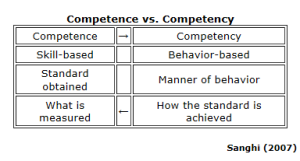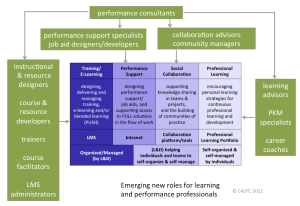We use the term, we include in job descriptions but what is this “competency” stuff and what will it include for future learning and performance professionals to succeed in the next 5-10 years? I am excited to lead a session at the Learning Solutions Conference in March focused on Who Is the Next-gen Worker (and Are We Ready for Them?). I plan to build out the elements the group thinks the employee of 2018 will need, the desired technical, interpersonal, collaboration, social intelligence skills and attributes. I invite your feedback as I focus on building a baseline and look for ideas going forward that I will share at the conference. In a future Musings I will report back the group response!
Here is where I begin, competency is the ability someone has to perform, or do, a job accurately and  effectively. Each job contains sets of defined behaviors that compose a type of process map guiding the individual to perform the tasks needed for success and to identify new skills and behaviors for future jobs. “While there are many definitions of competency, most of them have two common elements: The competency is an observable and measurable knowledge and skills.
effectively. Each job contains sets of defined behaviors that compose a type of process map guiding the individual to perform the tasks needed for success and to identify new skills and behaviors for future jobs. “While there are many definitions of competency, most of them have two common elements: The competency is an observable and measurable knowledge and skills.
Key to this exercise is the focus on performance, competencies should be  more than simply the tasks an individual needs to perform they need to include the characteristics a person needs to perform at the highest level. In the early 1990’s research was conducted that created the “capability model” that outlines performance as the capabilities that make effective performance possible. The model has three components: Individual Attributes, Competencies, and Outcomes, which feed into each other (Northouse, 2004).
more than simply the tasks an individual needs to perform they need to include the characteristics a person needs to perform at the highest level. In the early 1990’s research was conducted that created the “capability model” that outlines performance as the capabilities that make effective performance possible. The model has three components: Individual Attributes, Competencies, and Outcomes, which feed into each other (Northouse, 2004).
ASTD (American Society for Training & Development) recently updated its model to better define the skills  and knowledge the learning professional needs to be successful. “It captures changes driven by digital, mobile, and social technology; demographic shifts; globalization; and economic forces” and “emphasizes: (1) foundational competencies, or those that are important to everyone in the field, and (2) the specific areas of expertise (AOEs), which are the specialized knowledge and actions required by specific roles.” Click on the image and follow the link, each of the 10 Areas of Expertise for the training & learning professional, as well as the 6 Foundational competencies are described in greater detail, I’ll wait here for you.
and knowledge the learning professional needs to be successful. “It captures changes driven by digital, mobile, and social technology; demographic shifts; globalization; and economic forces” and “emphasizes: (1) foundational competencies, or those that are important to everyone in the field, and (2) the specific areas of expertise (AOEs), which are the specialized knowledge and actions required by specific roles.” Click on the image and follow the link, each of the 10 Areas of Expertise for the training & learning professional, as well as the 6 Foundational competencies are described in greater detail, I’ll wait here for you.
ASTD has created a solid framework to start from; it meets today’s needs for hiring. Looking forward we will need to bring skilled employees onboard that can demonstrate (what we call today) new and emerging competencies. I welcome your input and propose the following two key competency areas I believe we will need to include in a L&D professional: digital competencies (including curation and social learning skills) and leadership initiative. Jane Hart calls these types of employees, “smart workers”, and the role they serve reaches outside the traditional L&D functional area. They will lead efforts integrating talent management platforms and functions into a seamless learning support system while working with their business partners to align performance and learning efforts to defined strategies and goals.
in a L&D professional: digital competencies (including curation and social learning skills) and leadership initiative. Jane Hart calls these types of employees, “smart workers”, and the role they serve reaches outside the traditional L&D functional area. They will lead efforts integrating talent management platforms and functions into a seamless learning support system while working with their business partners to align performance and learning efforts to defined strategies and goals.
Harold Jarche mapped out his ideas that bear review and possible inclusion focused on digital competencies. The two that jump out to me include content curation and the social learning component. In the book Curation  Nation, Steven Rosenbaum describes it this way: “Curation replaces noise with clarity. And it’s the clarity of your choosing; it’s the things that people you trust help you find.”
Nation, Steven Rosenbaum describes it this way: “Curation replaces noise with clarity. And it’s the clarity of your choosing; it’s the things that people you trust help you find.”
We will look for employees that can create and nurture a culture of collaboration connecting people to solutions using the tools they need to reach our increasing mobile and agile workforce. I will look for employees who can help define metrics, who can measure the value and impact the learning solutions have and will analyze the data to identify trends and measure the effectiveness and efficiency the delivered solutions have on the business. I will look for people who understand they are “moving beyond the role of deliverer of training to a facilitator of learning, content curator, information manager, and builder of learning communities… designing and presenting learning not as a discrete event—a training course—but as a process that engages learners in a variety of ways over time through formal and informal channels.”
The last competency we need to plan for is leadership. We need to develop our own talent if we truly are focused on impacting performance and creating learning communities that will focus on individual success  based on sound design and support skills. Don Clark has spent some time building a competency model that he divided into:
based on sound design and support skills. Don Clark has spent some time building a competency model that he divided into:
- Core Competencies
- Leadership Competencies
- Professional Competencies
These three groups of competencies can be thought of as the Pyramid of Leadership, which collectively form the basic requirements for becoming a leader. I recommend you click on his Pyramid of Leadership and scroll through the site, he has explained each level in greater detail and offers insights on his thoughts.
Using the ASTD model as a base line and the two key thoughts of digital competencies and leadership what else will the L&D professional need to succeed in 2018? In this discussion what would you propose adding? What should be deleted or minimized? I gladly look for suggestions on how to prepare for the conference session coming up in mid-March and if you are going I hope you stop by! I leave you with some ideas Jane Hart has for roles the “smart worker” will be assuming today, I wonder what they will doing in 2018….
Jane & Harold both nailed the only comments I would add to clarify the ASTD model, and that is Performance Consulting as the skill/competency needed in the future. But I think it is important that the PC competency seeks to discover opportunities within the stakeholder/client organization for insertion of Performer Support (PS), and PS can be anything from knowledge assets to social collaborations with SMEs/peers/ forums, etc. To that end, there is another competency that will be important – CURATION. As more large organizations out-source, they will rely upon entities that can quickly respond with best-in-class-solutions. To do that having done diligence and knowing what is available will become a key driver.
Posted by Gary Wise | February 6, 2013, 2:10 pmI agree! If you search “curation” (or use the word cloud) I have posted several articles focused on the art, science, and design uses of curation. Thanks for the feedback!
Posted by wjryan | February 8, 2013, 11:10 amThank you so much for applying free time in order to create “What are
the competencies we need to succeed in the future?
� Monday Morning Musings”. Thanks a ton for a second time ,Rhea
Posted by http://tinyurl.com/publemma20390 | February 8, 2013, 9:03 amYou are welcome! If you get to LSCon I hope you join the session!
Posted by wjryan | February 8, 2013, 11:11 amHeck of an article. Deep and wide. Now how do you build and nurture talent in a dystopian corporate environment. That’s why I like consulting. I’ll take my chances on me. Great research – worth a doctoral thesis opener. The question I always have is who will listen or read academic treatment and get the full takeaway – then be able to express it in 20 words or less?
Posted by Rich | December 8, 2017, 5:33 pmThanks Rich. I have been able, as a consultant, to help develop hiring for competency models and begin career paths for organizations. Key is getting the HR, IT, Communication, and L&D teams working together early on.
Posted by wjryan | December 8, 2017, 5:55 pm